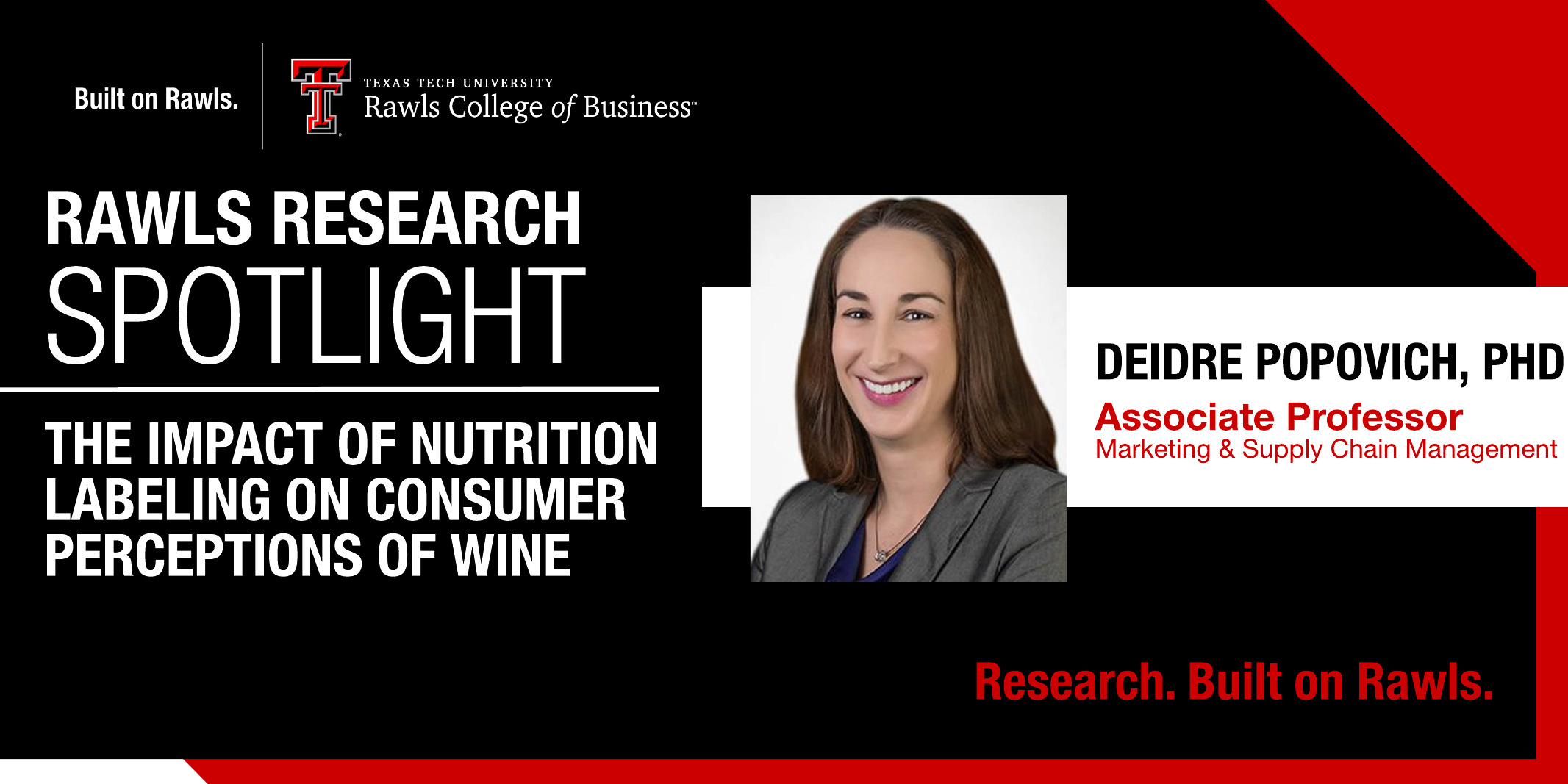
Story Spotlights
- Including nutrition labels with wine can decrease consumers' perception of the healthiness of wine.
- When consumers read nutrition labels on wine, they were more surprised by sugar levels than calories.
- Wine marketers and producers need to be ready for more transparency regarding nutritional information.
Malbecs are red, Cabernets are too; after reading nutrition labels, what will you do?
In the not-too-distant future, this may be a question consumers face when reaching for a bottle of wine. Deciding on a bottle of wine for Valentine's Day may go from picking between a dry red or sweet white to considering sugar content and the number of calories per serving.
In their recent article, “The Impact of Nutrition Labeling on Consumer Perceptions of Wine,” Deidre Popovich, associate professor of marketing at the Jerry S. Rawls College of Business, and Natalia Velikova, professor of hospitality and retail management at Texas Tech University, set out to explore the impact nutrition labels could have on wine consumers.
The research comes in response to the EU's 2023 policy that wine labels must now include a complete ingredient list associated with allergies and intolerances.
Though the U.S. has yet to pass a similar policy requiring nutrition labeling, the researchers wanted to know how, if at all, nutrition labels could impact consumers' perceptions of wine and their purchasing decisions.
The researchers noted that consumers may often categorize food along a virtue-vice spectrum. Virtue foods would aid long-term health goals but might not provide short-term enjoyment. Vice foods provide short-term enjoyment but might not aid long-term health goals.
“The vice/virtue distinction is based on consumer perceptions, rather than actual nutrition information,” wrote the researchers.
Wine, especially red wine, is typically considered more of a virtue due to health benefits often mentioned in popular press.
A Blend of Four Experiments
The researchers conducted four experiments, which included nearly 800 participants in total.
The first two experiments focused on the impact of a nutritional label and what nutritional information concerned participants most. The third experiment looked at the impact of serving size. The fourth experiment examined the perception of wine based on dieting consumers who are concerned with calorie intake.
In experiments one and two, the researchers found that consumers who read nutrition labels perceived wine as less healthy and were less likely to purchase it. This was consistent regardless of whether the wine was white or red.
This change in perception only happens if consumers spend time reading and understanding nutrition labels.
“However, [consumers] are generally not motivated to read or use this information,” wrote the researchers.
The researchers found the healthy perception of wine remained consistent between participants who were not given nutritional information and participants who were given nutritional information but were not required to read it.
The researchers found in experiment three that consumers were more concerned with sugar and serving size than the number of calories. Consumers were consistently far more surprised by the amount of sugar in a serving of wine than the number of calories.
Experiment four showed that dietary-restrained consumers, who were more concerned about calories, actually had a different view of wine.
“Counterintuitively, restrained eaters are more likely to rate wine as healthier, regardless of whether it is dry or sweet, when they are focused on calories,” wrote the researchers. “We argue these consumers tend to believe in the health benefits of wine and therefore drink more of it than their peers.”
Should We Whine about Nutrition Labels?
At first glance, it is easy to see why the wine industry may be hesitant to put nutrition labels on their bottles of wine. What good comes from providing information that creates a negative perception of a product and reduces the likelihood that a consumer will buy the product?
Popovich and Veliklova's research clearly showed that most consumers will not read the nutrition label unless they are prompted to.
“Nutrition labeling may function as a self-restraint aid,” wrote the researchers, “but only for those who are prompted to read and use this information in their decision-making and who are not restrained eaters.”
Those who will read nutrition labels will focus more on the sugar content and serving size than the number of calories. The researchers see this as an opportunity for winemakers and marketers.
“To aid customers with more informed purchasing decisions, wine companies can publish the grams of sugar per standard unit pour, as well as produce wine with lower sugar content,” wrote the researchers.
The researchers have some advice for winemakers: take some comfort in knowing that unless a consumer is on a diet, they probably are not using nutrition labels to make purchasing decisions.
However, that should not mean winemakers rest easy.
“The wine trade needs to be ready for more transparency regarding nutritional information,” wrote the researchers. “Evidence from industry suggests that this is likely to change soon.”
Read deidre popovich's companion article
Read the full article from the Journal of Consumer Marketing
